Digital Business and New Technologies: Report on AI in Business
VerifiedAdded on 2022/12/23
|9
|2698
|23
Report
AI Summary
This report delves into the realm of digital business and new technologies, primarily focusing on the application of artificial intelligence (AI) in business operations, using Sainsbury's as a case study. It explores the relevance of AI, its evolution, and the specific technologies implemented, such as Blue Yonder, for supply chain management. The report examines the types of businesses utilizing AI, its effectiveness as a business tool, and its association with course content. Furthermore, it discusses the relationship between digital technologies, including old theories like Bloom's digital taxonomy and new theories like connectivism, and their impact on business and management structures. The conclusion emphasizes the importance of leveraging various technologies for enhanced efficiency and profitability in business practices.
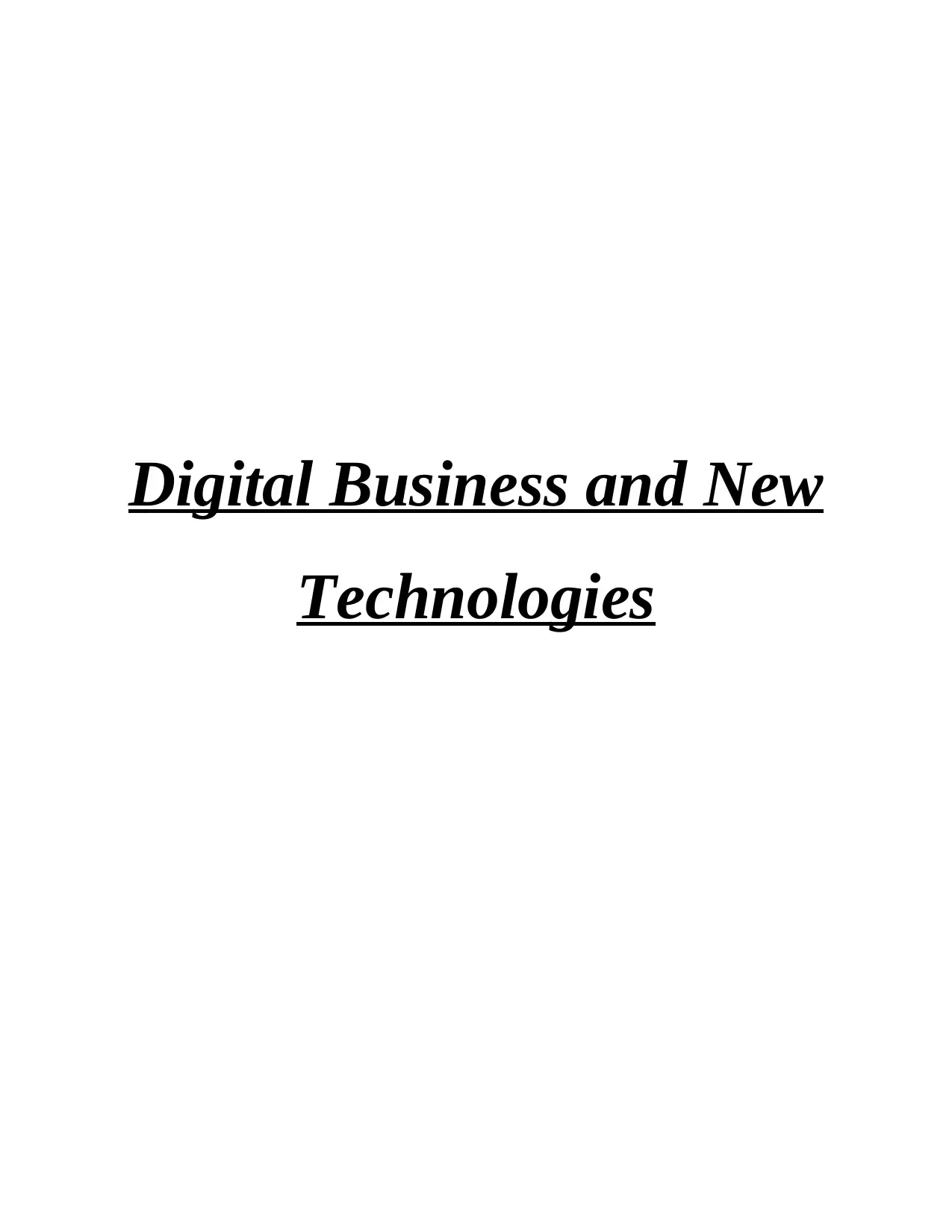
Digital Business and New
Technologies
Technologies
Paraphrase This Document
Need a fresh take? Get an instant paraphrase of this document with our AI Paraphraser
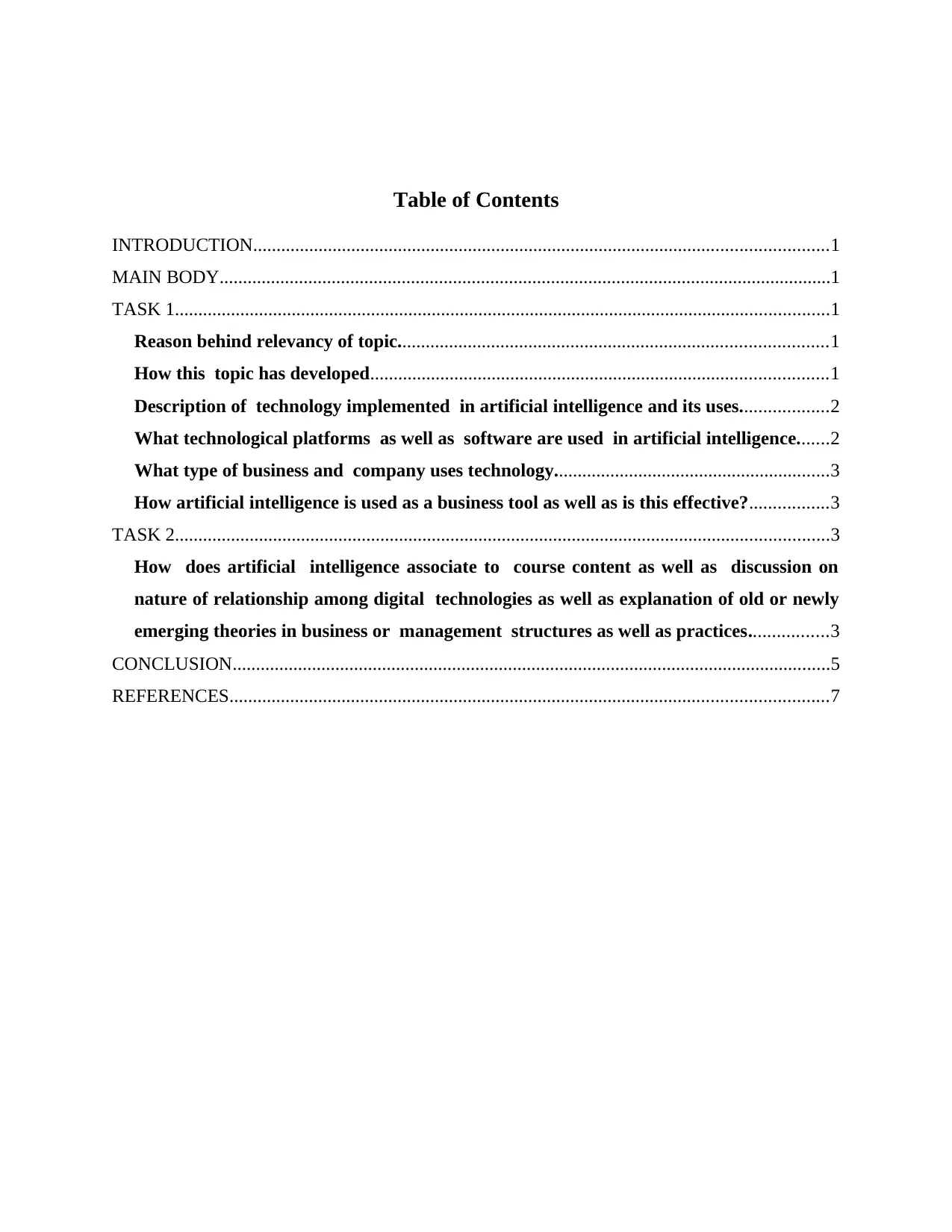
Table of Contents
INTRODUCTION...........................................................................................................................1
MAIN BODY...................................................................................................................................1
TASK 1............................................................................................................................................1
Reason behind relevancy of topic............................................................................................1
How this topic has developed..................................................................................................1
Description of technology implemented in artificial intelligence and its uses...................2
What technological platforms as well as software are used in artificial intelligence.......2
What type of business and company uses technology...........................................................3
How artificial intelligence is used as a business tool as well as is this effective?.................3
TASK 2............................................................................................................................................3
How does artificial intelligence associate to course content as well as discussion on
nature of relationship among digital technologies as well as explanation of old or newly
emerging theories in business or management structures as well as practices.................3
CONCLUSION................................................................................................................................5
REFERENCES................................................................................................................................7
INTRODUCTION...........................................................................................................................1
MAIN BODY...................................................................................................................................1
TASK 1............................................................................................................................................1
Reason behind relevancy of topic............................................................................................1
How this topic has developed..................................................................................................1
Description of technology implemented in artificial intelligence and its uses...................2
What technological platforms as well as software are used in artificial intelligence.......2
What type of business and company uses technology...........................................................3
How artificial intelligence is used as a business tool as well as is this effective?.................3
TASK 2............................................................................................................................................3
How does artificial intelligence associate to course content as well as discussion on
nature of relationship among digital technologies as well as explanation of old or newly
emerging theories in business or management structures as well as practices.................3
CONCLUSION................................................................................................................................5
REFERENCES................................................................................................................................7
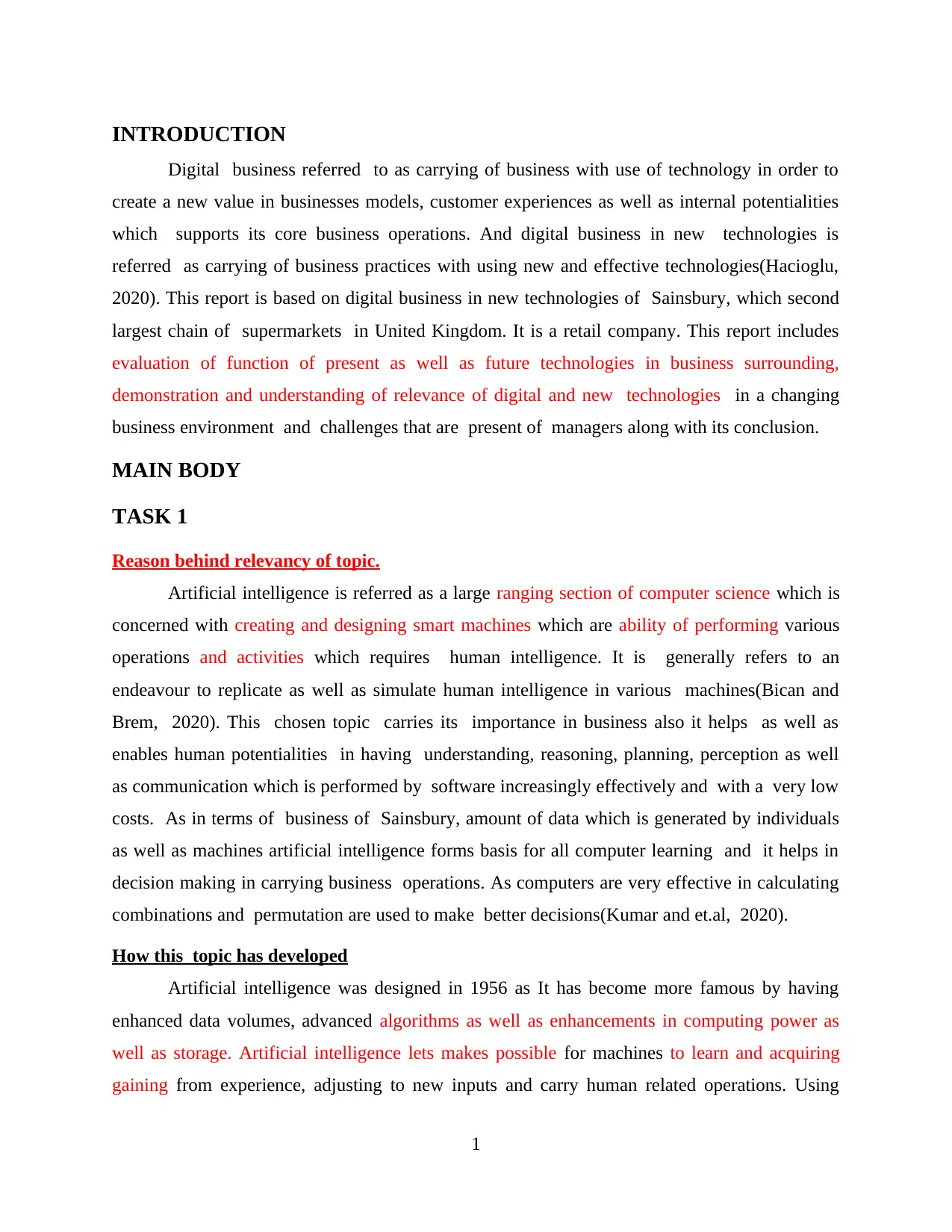
INTRODUCTION
Digital business referred to as carrying of business with use of technology in order to
create a new value in businesses models, customer experiences as well as internal potentialities
which supports its core business operations. And digital business in new technologies is
referred as carrying of business practices with using new and effective technologies(Hacioglu,
2020). This report is based on digital business in new technologies of Sainsbury, which second
largest chain of supermarkets in United Kingdom. It is a retail company. This report includes
evaluation of function of present as well as future technologies in business surrounding,
demonstration and understanding of relevance of digital and new technologies in a changing
business environment and challenges that are present of managers along with its conclusion.
MAIN BODY
TASK 1
Reason behind relevancy of topic.
Artificial intelligence is referred as a large ranging section of computer science which is
concerned with creating and designing smart machines which are ability of performing various
operations and activities which requires human intelligence. It is generally refers to an
endeavour to replicate as well as simulate human intelligence in various machines(Bican and
Brem, 2020). This chosen topic carries its importance in business also it helps as well as
enables human potentialities in having understanding, reasoning, planning, perception as well
as communication which is performed by software increasingly effectively and with a very low
costs. As in terms of business of Sainsbury, amount of data which is generated by individuals
as well as machines artificial intelligence forms basis for all computer learning and it helps in
decision making in carrying business operations. As computers are very effective in calculating
combinations and permutation are used to make better decisions(Kumar and et.al, 2020).
How this topic has developed
Artificial intelligence was designed in 1956 as It has become more famous by having
enhanced data volumes, advanced algorithms as well as enhancements in computing power as
well as storage. Artificial intelligence lets makes possible for machines to learn and acquiring
gaining from experience, adjusting to new inputs and carry human related operations. Using
1
Digital business referred to as carrying of business with use of technology in order to
create a new value in businesses models, customer experiences as well as internal potentialities
which supports its core business operations. And digital business in new technologies is
referred as carrying of business practices with using new and effective technologies(Hacioglu,
2020). This report is based on digital business in new technologies of Sainsbury, which second
largest chain of supermarkets in United Kingdom. It is a retail company. This report includes
evaluation of function of present as well as future technologies in business surrounding,
demonstration and understanding of relevance of digital and new technologies in a changing
business environment and challenges that are present of managers along with its conclusion.
MAIN BODY
TASK 1
Reason behind relevancy of topic.
Artificial intelligence is referred as a large ranging section of computer science which is
concerned with creating and designing smart machines which are ability of performing various
operations and activities which requires human intelligence. It is generally refers to an
endeavour to replicate as well as simulate human intelligence in various machines(Bican and
Brem, 2020). This chosen topic carries its importance in business also it helps as well as
enables human potentialities in having understanding, reasoning, planning, perception as well
as communication which is performed by software increasingly effectively and with a very low
costs. As in terms of business of Sainsbury, amount of data which is generated by individuals
as well as machines artificial intelligence forms basis for all computer learning and it helps in
decision making in carrying business operations. As computers are very effective in calculating
combinations and permutation are used to make better decisions(Kumar and et.al, 2020).
How this topic has developed
Artificial intelligence was designed in 1956 as It has become more famous by having
enhanced data volumes, advanced algorithms as well as enhancements in computing power as
well as storage. Artificial intelligence lets makes possible for machines to learn and acquiring
gaining from experience, adjusting to new inputs and carry human related operations. Using
1
⊘ This is a preview!⊘
Do you want full access?
Subscribe today to unlock all pages.

Trusted by 1+ million students worldwide
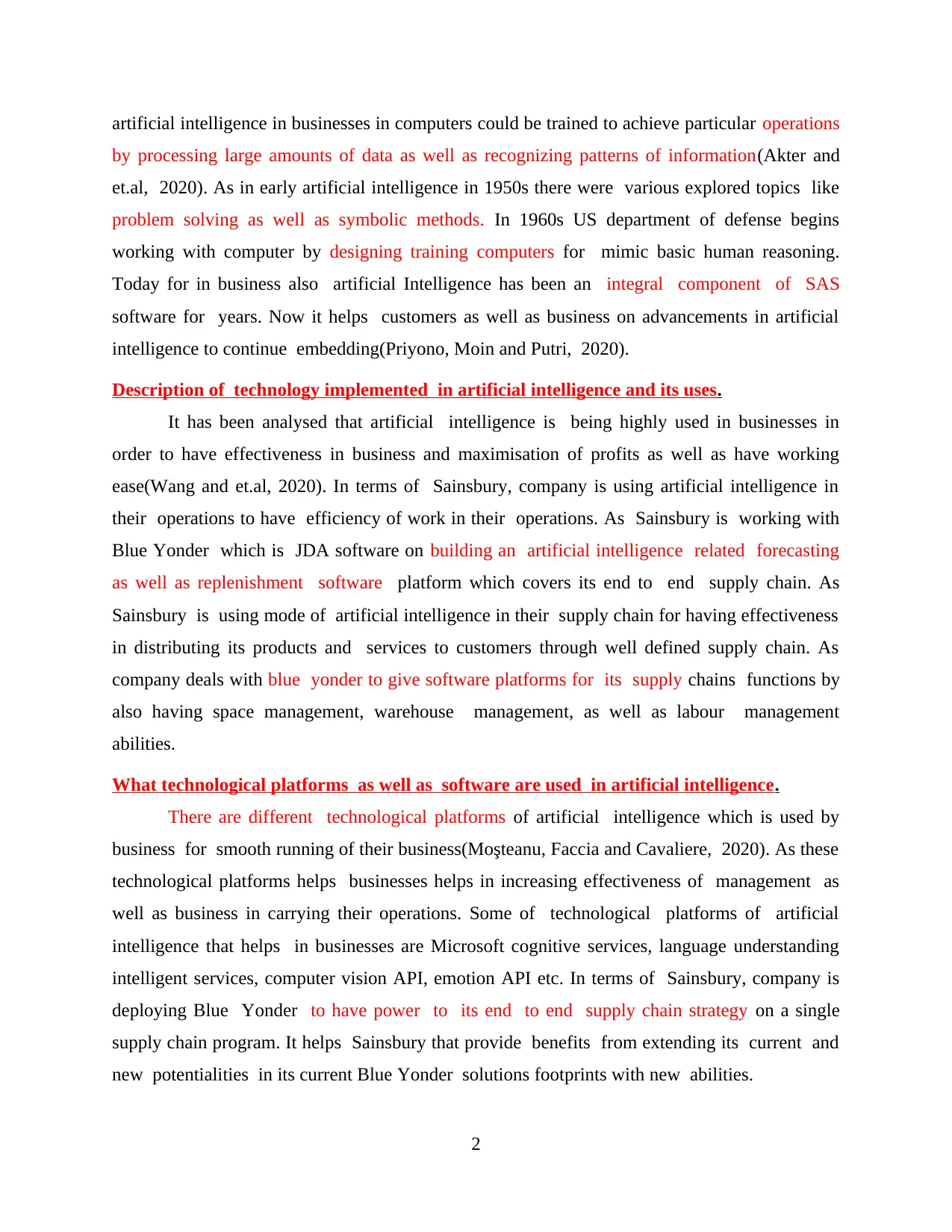
artificial intelligence in businesses in computers could be trained to achieve particular operations
by processing large amounts of data as well as recognizing patterns of information(Akter and
et.al, 2020). As in early artificial intelligence in 1950s there were various explored topics like
problem solving as well as symbolic methods. In 1960s US department of defense begins
working with computer by designing training computers for mimic basic human reasoning.
Today for in business also artificial Intelligence has been an integral component of SAS
software for years. Now it helps customers as well as business on advancements in artificial
intelligence to continue embedding(Priyono, Moin and Putri, 2020).
Description of technology implemented in artificial intelligence and its uses.
It has been analysed that artificial intelligence is being highly used in businesses in
order to have effectiveness in business and maximisation of profits as well as have working
ease(Wang and et.al, 2020). In terms of Sainsbury, company is using artificial intelligence in
their operations to have efficiency of work in their operations. As Sainsbury is working with
Blue Yonder which is JDA software on building an artificial intelligence related forecasting
as well as replenishment software platform which covers its end to end supply chain. As
Sainsbury is using mode of artificial intelligence in their supply chain for having effectiveness
in distributing its products and services to customers through well defined supply chain. As
company deals with blue yonder to give software platforms for its supply chains functions by
also having space management, warehouse management, as well as labour management
abilities.
What technological platforms as well as software are used in artificial intelligence.
There are different technological platforms of artificial intelligence which is used by
business for smooth running of their business(Moşteanu, Faccia and Cavaliere, 2020). As these
technological platforms helps businesses helps in increasing effectiveness of management as
well as business in carrying their operations. Some of technological platforms of artificial
intelligence that helps in businesses are Microsoft cognitive services, language understanding
intelligent services, computer vision API, emotion API etc. In terms of Sainsbury, company is
deploying Blue Yonder to have power to its end to end supply chain strategy on a single
supply chain program. It helps Sainsbury that provide benefits from extending its current and
new potentialities in its current Blue Yonder solutions footprints with new abilities.
2
by processing large amounts of data as well as recognizing patterns of information(Akter and
et.al, 2020). As in early artificial intelligence in 1950s there were various explored topics like
problem solving as well as symbolic methods. In 1960s US department of defense begins
working with computer by designing training computers for mimic basic human reasoning.
Today for in business also artificial Intelligence has been an integral component of SAS
software for years. Now it helps customers as well as business on advancements in artificial
intelligence to continue embedding(Priyono, Moin and Putri, 2020).
Description of technology implemented in artificial intelligence and its uses.
It has been analysed that artificial intelligence is being highly used in businesses in
order to have effectiveness in business and maximisation of profits as well as have working
ease(Wang and et.al, 2020). In terms of Sainsbury, company is using artificial intelligence in
their operations to have efficiency of work in their operations. As Sainsbury is working with
Blue Yonder which is JDA software on building an artificial intelligence related forecasting
as well as replenishment software platform which covers its end to end supply chain. As
Sainsbury is using mode of artificial intelligence in their supply chain for having effectiveness
in distributing its products and services to customers through well defined supply chain. As
company deals with blue yonder to give software platforms for its supply chains functions by
also having space management, warehouse management, as well as labour management
abilities.
What technological platforms as well as software are used in artificial intelligence.
There are different technological platforms of artificial intelligence which is used by
business for smooth running of their business(Moşteanu, Faccia and Cavaliere, 2020). As these
technological platforms helps businesses helps in increasing effectiveness of management as
well as business in carrying their operations. Some of technological platforms of artificial
intelligence that helps in businesses are Microsoft cognitive services, language understanding
intelligent services, computer vision API, emotion API etc. In terms of Sainsbury, company is
deploying Blue Yonder to have power to its end to end supply chain strategy on a single
supply chain program. It helps Sainsbury that provide benefits from extending its current and
new potentialities in its current Blue Yonder solutions footprints with new abilities.
2
Paraphrase This Document
Need a fresh take? Get an instant paraphrase of this document with our AI Paraphraser
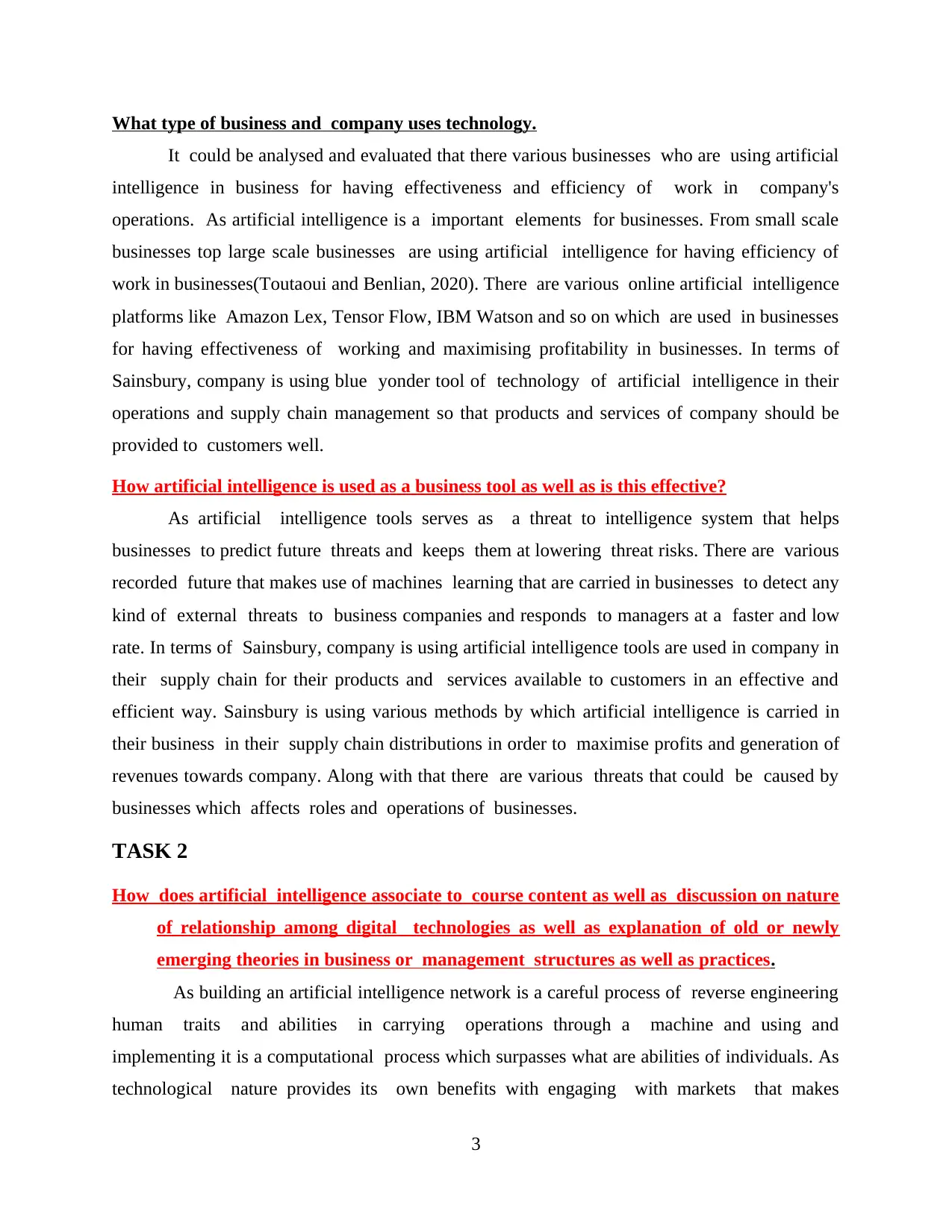
What type of business and company uses technology.
It could be analysed and evaluated that there various businesses who are using artificial
intelligence in business for having effectiveness and efficiency of work in company's
operations. As artificial intelligence is a important elements for businesses. From small scale
businesses top large scale businesses are using artificial intelligence for having efficiency of
work in businesses(Toutaoui and Benlian, 2020). There are various online artificial intelligence
platforms like Amazon Lex, Tensor Flow, IBM Watson and so on which are used in businesses
for having effectiveness of working and maximising profitability in businesses. In terms of
Sainsbury, company is using blue yonder tool of technology of artificial intelligence in their
operations and supply chain management so that products and services of company should be
provided to customers well.
How artificial intelligence is used as a business tool as well as is this effective?
As artificial intelligence tools serves as a threat to intelligence system that helps
businesses to predict future threats and keeps them at lowering threat risks. There are various
recorded future that makes use of machines learning that are carried in businesses to detect any
kind of external threats to business companies and responds to managers at a faster and low
rate. In terms of Sainsbury, company is using artificial intelligence tools are used in company in
their supply chain for their products and services available to customers in an effective and
efficient way. Sainsbury is using various methods by which artificial intelligence is carried in
their business in their supply chain distributions in order to maximise profits and generation of
revenues towards company. Along with that there are various threats that could be caused by
businesses which affects roles and operations of businesses.
TASK 2
How does artificial intelligence associate to course content as well as discussion on nature
of relationship among digital technologies as well as explanation of old or newly
emerging theories in business or management structures as well as practices.
As building an artificial intelligence network is a careful process of reverse engineering
human traits and abilities in carrying operations through a machine and using and
implementing it is a computational process which surpasses what are abilities of individuals. As
technological nature provides its own benefits with engaging with markets that makes
3
It could be analysed and evaluated that there various businesses who are using artificial
intelligence in business for having effectiveness and efficiency of work in company's
operations. As artificial intelligence is a important elements for businesses. From small scale
businesses top large scale businesses are using artificial intelligence for having efficiency of
work in businesses(Toutaoui and Benlian, 2020). There are various online artificial intelligence
platforms like Amazon Lex, Tensor Flow, IBM Watson and so on which are used in businesses
for having effectiveness of working and maximising profitability in businesses. In terms of
Sainsbury, company is using blue yonder tool of technology of artificial intelligence in their
operations and supply chain management so that products and services of company should be
provided to customers well.
How artificial intelligence is used as a business tool as well as is this effective?
As artificial intelligence tools serves as a threat to intelligence system that helps
businesses to predict future threats and keeps them at lowering threat risks. There are various
recorded future that makes use of machines learning that are carried in businesses to detect any
kind of external threats to business companies and responds to managers at a faster and low
rate. In terms of Sainsbury, company is using artificial intelligence tools are used in company in
their supply chain for their products and services available to customers in an effective and
efficient way. Sainsbury is using various methods by which artificial intelligence is carried in
their business in their supply chain distributions in order to maximise profits and generation of
revenues towards company. Along with that there are various threats that could be caused by
businesses which affects roles and operations of businesses.
TASK 2
How does artificial intelligence associate to course content as well as discussion on nature
of relationship among digital technologies as well as explanation of old or newly
emerging theories in business or management structures as well as practices.
As building an artificial intelligence network is a careful process of reverse engineering
human traits and abilities in carrying operations through a machine and using and
implementing it is a computational process which surpasses what are abilities of individuals. As
technological nature provides its own benefits with engaging with markets that makes
3
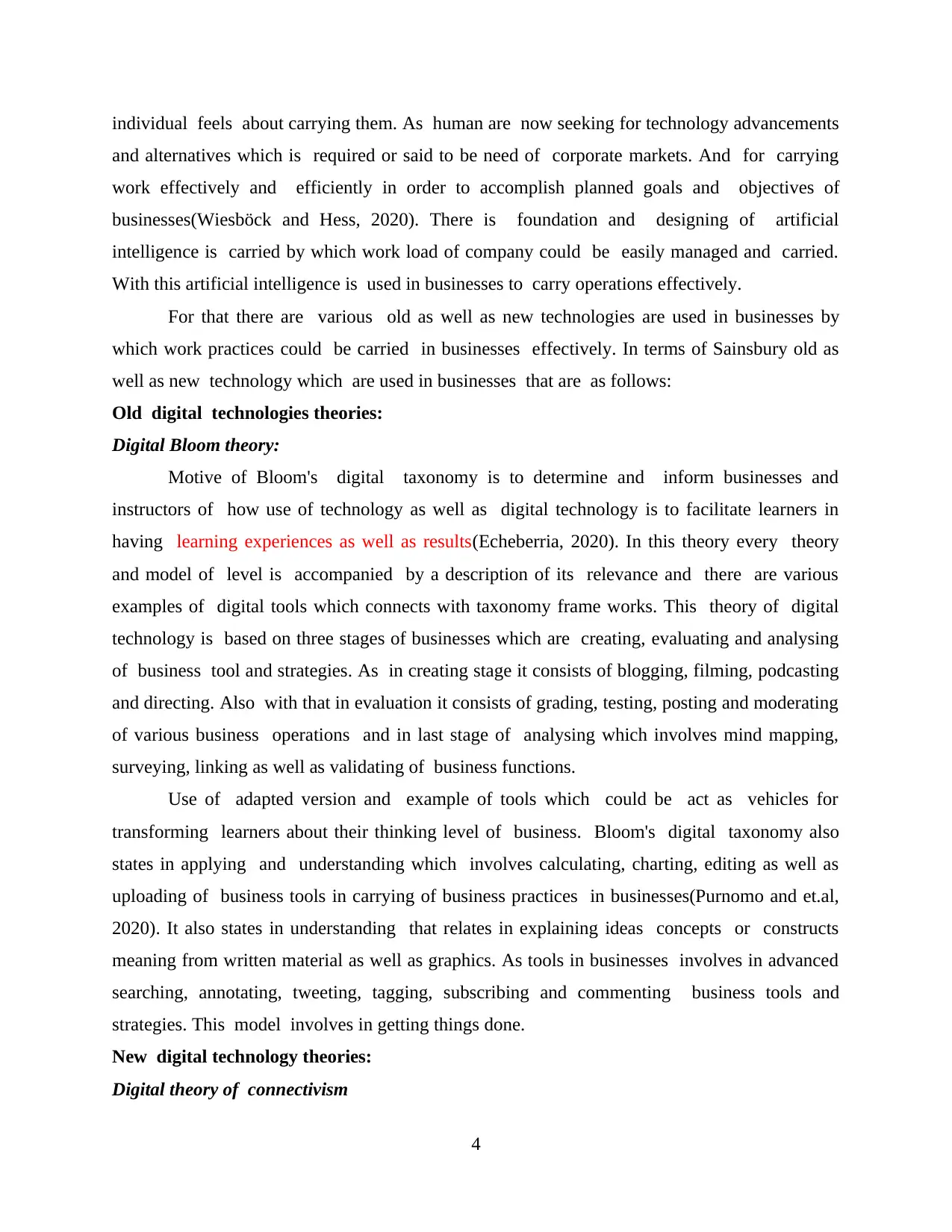
individual feels about carrying them. As human are now seeking for technology advancements
and alternatives which is required or said to be need of corporate markets. And for carrying
work effectively and efficiently in order to accomplish planned goals and objectives of
businesses(Wiesböck and Hess, 2020). There is foundation and designing of artificial
intelligence is carried by which work load of company could be easily managed and carried.
With this artificial intelligence is used in businesses to carry operations effectively.
For that there are various old as well as new technologies are used in businesses by
which work practices could be carried in businesses effectively. In terms of Sainsbury old as
well as new technology which are used in businesses that are as follows:
Old digital technologies theories:
Digital Bloom theory:
Motive of Bloom's digital taxonomy is to determine and inform businesses and
instructors of how use of technology as well as digital technology is to facilitate learners in
having learning experiences as well as results(Echeberria, 2020). In this theory every theory
and model of level is accompanied by a description of its relevance and there are various
examples of digital tools which connects with taxonomy frame works. This theory of digital
technology is based on three stages of businesses which are creating, evaluating and analysing
of business tool and strategies. As in creating stage it consists of blogging, filming, podcasting
and directing. Also with that in evaluation it consists of grading, testing, posting and moderating
of various business operations and in last stage of analysing which involves mind mapping,
surveying, linking as well as validating of business functions.
Use of adapted version and example of tools which could be act as vehicles for
transforming learners about their thinking level of business. Bloom's digital taxonomy also
states in applying and understanding which involves calculating, charting, editing as well as
uploading of business tools in carrying of business practices in businesses(Purnomo and et.al,
2020). It also states in understanding that relates in explaining ideas concepts or constructs
meaning from written material as well as graphics. As tools in businesses involves in advanced
searching, annotating, tweeting, tagging, subscribing and commenting business tools and
strategies. This model involves in getting things done.
New digital technology theories:
Digital theory of connectivism
4
and alternatives which is required or said to be need of corporate markets. And for carrying
work effectively and efficiently in order to accomplish planned goals and objectives of
businesses(Wiesböck and Hess, 2020). There is foundation and designing of artificial
intelligence is carried by which work load of company could be easily managed and carried.
With this artificial intelligence is used in businesses to carry operations effectively.
For that there are various old as well as new technologies are used in businesses by
which work practices could be carried in businesses effectively. In terms of Sainsbury old as
well as new technology which are used in businesses that are as follows:
Old digital technologies theories:
Digital Bloom theory:
Motive of Bloom's digital taxonomy is to determine and inform businesses and
instructors of how use of technology as well as digital technology is to facilitate learners in
having learning experiences as well as results(Echeberria, 2020). In this theory every theory
and model of level is accompanied by a description of its relevance and there are various
examples of digital tools which connects with taxonomy frame works. This theory of digital
technology is based on three stages of businesses which are creating, evaluating and analysing
of business tool and strategies. As in creating stage it consists of blogging, filming, podcasting
and directing. Also with that in evaluation it consists of grading, testing, posting and moderating
of various business operations and in last stage of analysing which involves mind mapping,
surveying, linking as well as validating of business functions.
Use of adapted version and example of tools which could be act as vehicles for
transforming learners about their thinking level of business. Bloom's digital taxonomy also
states in applying and understanding which involves calculating, charting, editing as well as
uploading of business tools in carrying of business practices in businesses(Purnomo and et.al,
2020). It also states in understanding that relates in explaining ideas concepts or constructs
meaning from written material as well as graphics. As tools in businesses involves in advanced
searching, annotating, tweeting, tagging, subscribing and commenting business tools and
strategies. This model involves in getting things done.
New digital technology theories:
Digital theory of connectivism
4
⊘ This is a preview!⊘
Do you want full access?
Subscribe today to unlock all pages.

Trusted by 1+ million students worldwide
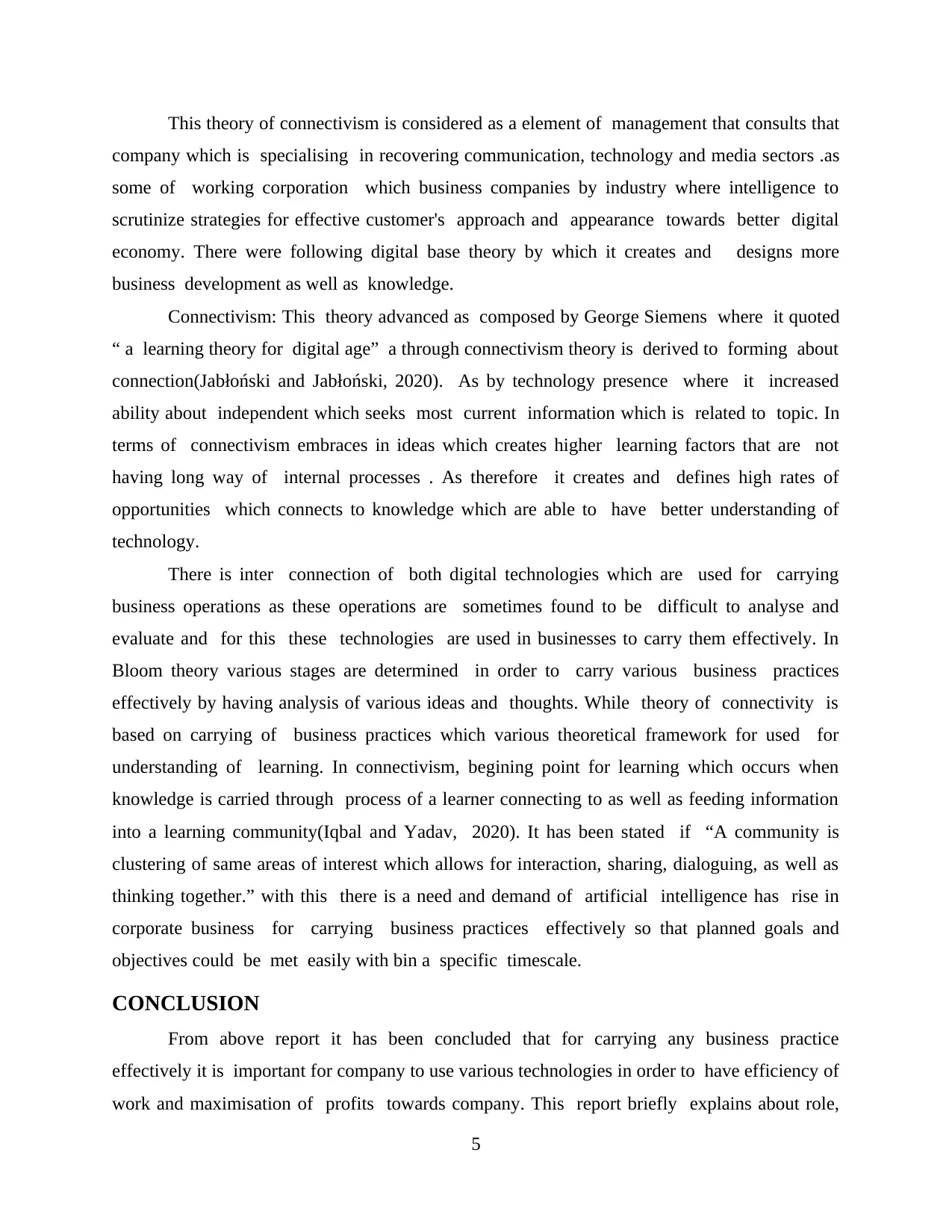
This theory of connectivism is considered as a element of management that consults that
company which is specialising in recovering communication, technology and media sectors .as
some of working corporation which business companies by industry where intelligence to
scrutinize strategies for effective customer's approach and appearance towards better digital
economy. There were following digital base theory by which it creates and designs more
business development as well as knowledge.
Connectivism: This theory advanced as composed by George Siemens where it quoted
“ a learning theory for digital age” a through connectivism theory is derived to forming about
connection(Jabłoński and Jabłoński, 2020). As by technology presence where it increased
ability about independent which seeks most current information which is related to topic. In
terms of connectivism embraces in ideas which creates higher learning factors that are not
having long way of internal processes . As therefore it creates and defines high rates of
opportunities which connects to knowledge which are able to have better understanding of
technology.
There is inter connection of both digital technologies which are used for carrying
business operations as these operations are sometimes found to be difficult to analyse and
evaluate and for this these technologies are used in businesses to carry them effectively. In
Bloom theory various stages are determined in order to carry various business practices
effectively by having analysis of various ideas and thoughts. While theory of connectivity is
based on carrying of business practices which various theoretical framework for used for
understanding of learning. In connectivism, begining point for learning which occurs when
knowledge is carried through process of a learner connecting to as well as feeding information
into a learning community(Iqbal and Yadav, 2020). It has been stated if “A community is
clustering of same areas of interest which allows for interaction, sharing, dialoguing, as well as
thinking together.” with this there is a need and demand of artificial intelligence has rise in
corporate business for carrying business practices effectively so that planned goals and
objectives could be met easily with bin a specific timescale.
CONCLUSION
From above report it has been concluded that for carrying any business practice
effectively it is important for company to use various technologies in order to have efficiency of
work and maximisation of profits towards company. This report briefly explains about role,
5
company which is specialising in recovering communication, technology and media sectors .as
some of working corporation which business companies by industry where intelligence to
scrutinize strategies for effective customer's approach and appearance towards better digital
economy. There were following digital base theory by which it creates and designs more
business development as well as knowledge.
Connectivism: This theory advanced as composed by George Siemens where it quoted
“ a learning theory for digital age” a through connectivism theory is derived to forming about
connection(Jabłoński and Jabłoński, 2020). As by technology presence where it increased
ability about independent which seeks most current information which is related to topic. In
terms of connectivism embraces in ideas which creates higher learning factors that are not
having long way of internal processes . As therefore it creates and defines high rates of
opportunities which connects to knowledge which are able to have better understanding of
technology.
There is inter connection of both digital technologies which are used for carrying
business operations as these operations are sometimes found to be difficult to analyse and
evaluate and for this these technologies are used in businesses to carry them effectively. In
Bloom theory various stages are determined in order to carry various business practices
effectively by having analysis of various ideas and thoughts. While theory of connectivity is
based on carrying of business practices which various theoretical framework for used for
understanding of learning. In connectivism, begining point for learning which occurs when
knowledge is carried through process of a learner connecting to as well as feeding information
into a learning community(Iqbal and Yadav, 2020). It has been stated if “A community is
clustering of same areas of interest which allows for interaction, sharing, dialoguing, as well as
thinking together.” with this there is a need and demand of artificial intelligence has rise in
corporate business for carrying business practices effectively so that planned goals and
objectives could be met easily with bin a specific timescale.
CONCLUSION
From above report it has been concluded that for carrying any business practice
effectively it is important for company to use various technologies in order to have efficiency of
work and maximisation of profits towards company. This report briefly explains about role,
5
Paraphrase This Document
Need a fresh take? Get an instant paraphrase of this document with our AI Paraphraser

function and purpose of old technologies as well as new technologies in business in order to
carry business practices effectively. There is also an interconnection of old technologies and
new technologies which are used in business.
6
carry business practices effectively. There is also an interconnection of old technologies and
new technologies which are used in business.
6
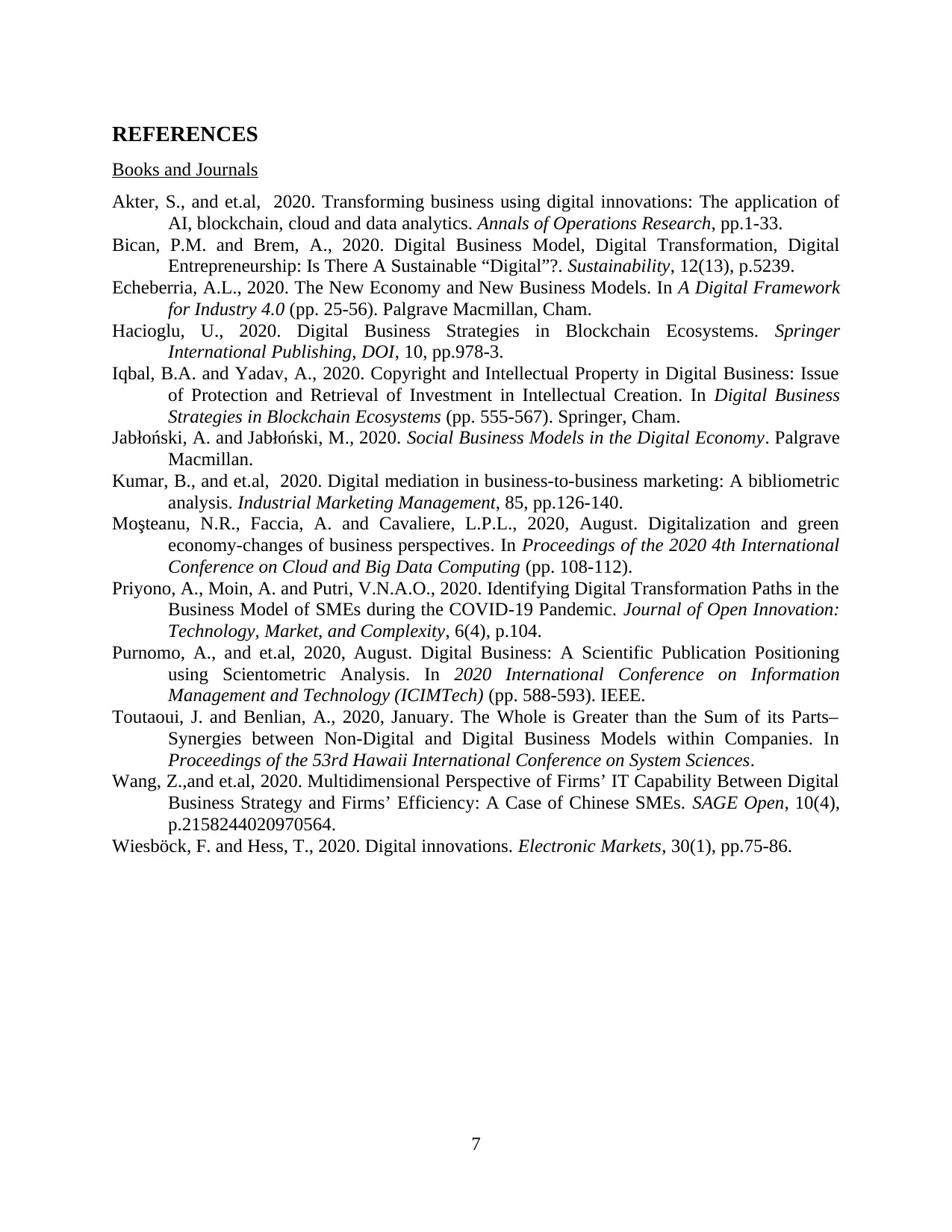
REFERENCES
Books and Journals
Akter, S., and et.al, 2020. Transforming business using digital innovations: The application of
AI, blockchain, cloud and data analytics. Annals of Operations Research, pp.1-33.
Bican, P.M. and Brem, A., 2020. Digital Business Model, Digital Transformation, Digital
Entrepreneurship: Is There A Sustainable “Digital”?. Sustainability, 12(13), p.5239.
Echeberria, A.L., 2020. The New Economy and New Business Models. In A Digital Framework
for Industry 4.0 (pp. 25-56). Palgrave Macmillan, Cham.
Hacioglu, U., 2020. Digital Business Strategies in Blockchain Ecosystems. Springer
International Publishing, DOI, 10, pp.978-3.
Iqbal, B.A. and Yadav, A., 2020. Copyright and Intellectual Property in Digital Business: Issue
of Protection and Retrieval of Investment in Intellectual Creation. In Digital Business
Strategies in Blockchain Ecosystems (pp. 555-567). Springer, Cham.
Jabłoński, A. and Jabłoński, M., 2020. Social Business Models in the Digital Economy. Palgrave
Macmillan.
Kumar, B., and et.al, 2020. Digital mediation in business-to-business marketing: A bibliometric
analysis. Industrial Marketing Management, 85, pp.126-140.
Moşteanu, N.R., Faccia, A. and Cavaliere, L.P.L., 2020, August. Digitalization and green
economy-changes of business perspectives. In Proceedings of the 2020 4th International
Conference on Cloud and Big Data Computing (pp. 108-112).
Priyono, A., Moin, A. and Putri, V.N.A.O., 2020. Identifying Digital Transformation Paths in the
Business Model of SMEs during the COVID-19 Pandemic. Journal of Open Innovation:
Technology, Market, and Complexity, 6(4), p.104.
Purnomo, A., and et.al, 2020, August. Digital Business: A Scientific Publication Positioning
using Scientometric Analysis. In 2020 International Conference on Information
Management and Technology (ICIMTech) (pp. 588-593). IEEE.
Toutaoui, J. and Benlian, A., 2020, January. The Whole is Greater than the Sum of its Parts–
Synergies between Non-Digital and Digital Business Models within Companies. In
Proceedings of the 53rd Hawaii International Conference on System Sciences.
Wang, Z.,and et.al, 2020. Multidimensional Perspective of Firms’ IT Capability Between Digital
Business Strategy and Firms’ Efficiency: A Case of Chinese SMEs. SAGE Open, 10(4),
p.2158244020970564.
Wiesböck, F. and Hess, T., 2020. Digital innovations. Electronic Markets, 30(1), pp.75-86.
7
Books and Journals
Akter, S., and et.al, 2020. Transforming business using digital innovations: The application of
AI, blockchain, cloud and data analytics. Annals of Operations Research, pp.1-33.
Bican, P.M. and Brem, A., 2020. Digital Business Model, Digital Transformation, Digital
Entrepreneurship: Is There A Sustainable “Digital”?. Sustainability, 12(13), p.5239.
Echeberria, A.L., 2020. The New Economy and New Business Models. In A Digital Framework
for Industry 4.0 (pp. 25-56). Palgrave Macmillan, Cham.
Hacioglu, U., 2020. Digital Business Strategies in Blockchain Ecosystems. Springer
International Publishing, DOI, 10, pp.978-3.
Iqbal, B.A. and Yadav, A., 2020. Copyright and Intellectual Property in Digital Business: Issue
of Protection and Retrieval of Investment in Intellectual Creation. In Digital Business
Strategies in Blockchain Ecosystems (pp. 555-567). Springer, Cham.
Jabłoński, A. and Jabłoński, M., 2020. Social Business Models in the Digital Economy. Palgrave
Macmillan.
Kumar, B., and et.al, 2020. Digital mediation in business-to-business marketing: A bibliometric
analysis. Industrial Marketing Management, 85, pp.126-140.
Moşteanu, N.R., Faccia, A. and Cavaliere, L.P.L., 2020, August. Digitalization and green
economy-changes of business perspectives. In Proceedings of the 2020 4th International
Conference on Cloud and Big Data Computing (pp. 108-112).
Priyono, A., Moin, A. and Putri, V.N.A.O., 2020. Identifying Digital Transformation Paths in the
Business Model of SMEs during the COVID-19 Pandemic. Journal of Open Innovation:
Technology, Market, and Complexity, 6(4), p.104.
Purnomo, A., and et.al, 2020, August. Digital Business: A Scientific Publication Positioning
using Scientometric Analysis. In 2020 International Conference on Information
Management and Technology (ICIMTech) (pp. 588-593). IEEE.
Toutaoui, J. and Benlian, A., 2020, January. The Whole is Greater than the Sum of its Parts–
Synergies between Non-Digital and Digital Business Models within Companies. In
Proceedings of the 53rd Hawaii International Conference on System Sciences.
Wang, Z.,and et.al, 2020. Multidimensional Perspective of Firms’ IT Capability Between Digital
Business Strategy and Firms’ Efficiency: A Case of Chinese SMEs. SAGE Open, 10(4),
p.2158244020970564.
Wiesböck, F. and Hess, T., 2020. Digital innovations. Electronic Markets, 30(1), pp.75-86.
7
⊘ This is a preview!⊘
Do you want full access?
Subscribe today to unlock all pages.

Trusted by 1+ million students worldwide
1 out of 9
Related Documents
Your All-in-One AI-Powered Toolkit for Academic Success.
+13062052269
info@desklib.com
Available 24*7 on WhatsApp / Email
![[object Object]](/_next/static/media/star-bottom.7253800d.svg)
Unlock your academic potential
Copyright © 2020–2025 A2Z Services. All Rights Reserved. Developed and managed by ZUCOL.





